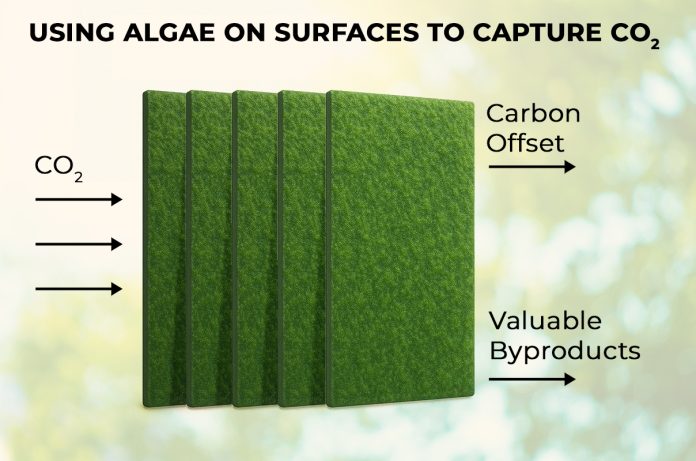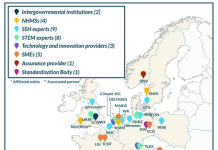As the urgency to achieve net-zero intensifies, capital allocation toward carbon removal technologies is becoming more selective, competitive, and performance-driven
This whitepaper presents a rigorous comparative analysis of Direct Air Capture with Carbon Storage (DACCS) technologies, with a focus on economic viability, system resilience, and long-term value creation (LTVC).
We examine the performance of high-cost, infrastructure-intensive solid sorbent systems such as Heirloom’s DAC facilities, alongside a next-generation, modular, nature-integrated approach represented by Passive Algae-Based DAC systems developed by Reactive Surfaces and Like Lichen (RS/LL).
Using a comprehensive LTVC framework — including CAPEX/OPEX efficiency, carbon credit pricing potential, ICVCM Core Carbon Principles (CCP) alignment, social and circular economy co-benefits, and operational resilience — this white paper demonstrates that Passive Algae-Based DAC offers superior scalability, cost efficiency, and socioeconomic returns compared to conventional DACCS models. This has profound implications for both macroeconomic policy decisions and microeconomic project development strategies in the Voluntary Carbon Market (VCM). The analysis further underscores the principle that “economics matters”—not as a constraint, but as a multiplier of climate impact, credibility, and investability in the global carbon removal ecosystem.
Introduction: The climate economy’s inconvenient truth – economics matters
As carbon removal becomes a pillar of global net-zero strategies, the race is on to scale technologies that can remove billions of tons of CO₂ from the atmosphere. Governments, companies, and investors are committing unprecedented resources to this effort — but which technologies deserve that capital?
As the global carbon markets mature, the focus of certification standards and carbon removal protocols has rightly centred on the verifiable, durable sequestration of CO₂e. However, these frameworks often neglect a critical dimension: the long-term financial and systemic viability of the technologies they accredit. Many current carbon removal approaches, while scientifically valid in terms of CO₂ capture, are economically brittle — heavily reliant on subsidies, costly infrastructure, and limited in their ability to generate lasting returns or broader societal value. This narrow view poses a structural risk to the global decarbonization agenda by channelling capital into solutions that may prove unsustainable, unscalable, or misaligned with circular economic principles.
While environmentally sustainable solutions demand focused action, economic rationality cannot be ignored in the capital decision-making process to finance such projects. Identifying and deploying carbon removal solutions that are not only environmentally effective but also economically resilient and systemically regenerative is the right approach. This concept is referred to by many different names, but is often known as Long-Term Value Creation (LTVC).
LTVC is the combination of economic/financial performance, environmental durability, socioeconomic (circular) impact, and resilience (the capacity of the CO2e removal system and the carbon engineering project development overall to withstand, recover from, and adapt to disruptive events and changing conditions while maintaining its essential functions and ability to thrive long-term) — must drive carbon removal investment decisions at the national, regional, community, company level – and especially at the technology level.
It’s not enough to just pull CO₂ from the air. We must ask:
At what cost? With what risks? And what benefits does it offer to society and future generations?
We apply this lens to evaluate two different Direct Air Carbon Capture and Storage (DACCS) carbon removal technologies: a conventional Solid Sorbent DACCS system vs. a Passive DAC modular, algae-based photobioreactor (PBR) carbon capture platform. By comparison, we can demonstrate how one of these direct air capture technologies actually delivers on an LTVC outcome, enhancing stakeholder value while mitigating systemic risks and supporting decentralised carbon infrastructure and enabling carbon removals at scale. Specifically, the Passive DAC PBR technology exemplifies a next-generation carbon removal model—one that aligns with both climate imperatives and long-term economic development goals by integrating low-cost materials, durable sequestration via biochar, and producing valuable low-carbon co-products to build circular bio economies at scale.
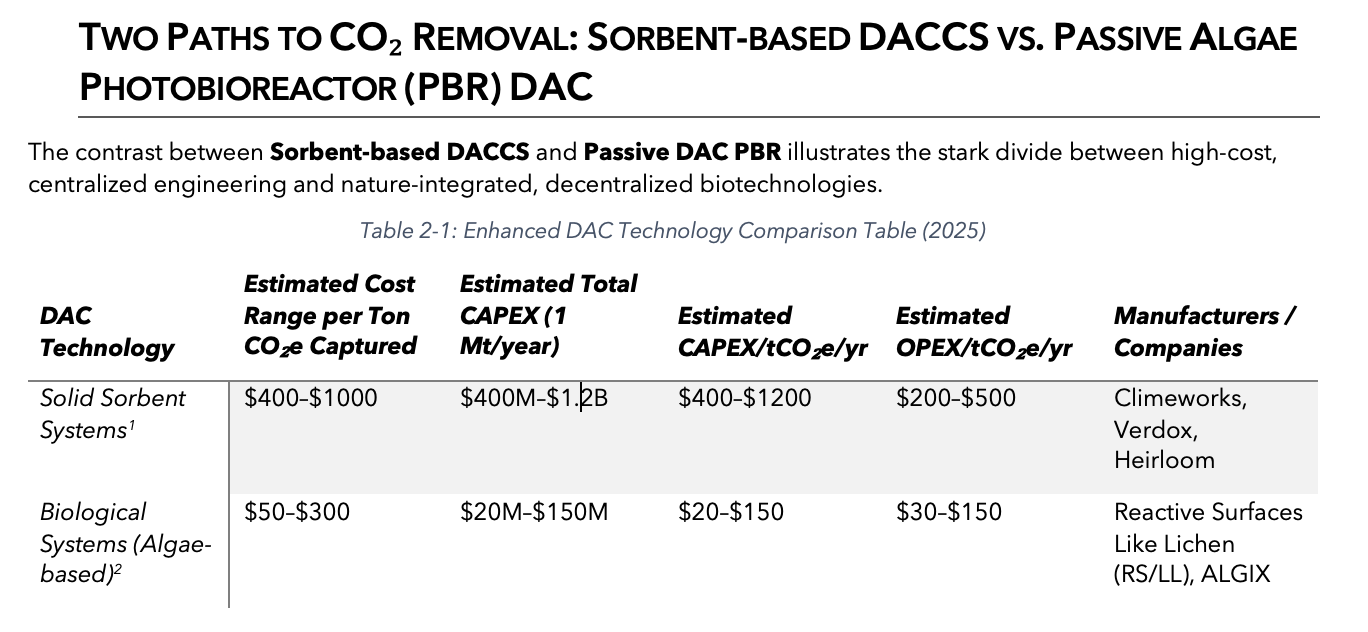
Passive algae-based DAC wins on the economics
In the global race to scale durable carbon dioxide removals (CDRs), cost-effectiveness is not just a metric — it’s a gatekeeper. Technologies that cannot remove CO₂ affordably and reliably will struggle to attract the necessary capital, public support, and policy backing to achieve gigaton-scale deployment. Passive Algae-Based DAC systems emerge as the most economically rational solution in this context: similar tCO2e removals at a fraction of the cost, and adding multiple profitable offtake revenue streams that are not achievable with conventional DACCS.
Revenue streams:
- Sorbent-based DACCS: Very limited offtake products; primarily relies only on carbon credit monetisation.
- Passive Algae Photobioreactor (PBR) DAC: Multiple offtake products: Biochar, graphene, bioplastics, soil amendments, and water remediation — all with market value.
Cost efficiency:
- Sorbent-based DACCS costs up to 20x more in CAPEX and 5–10x more in OPEX per ton of CO₂e removed than RS/LL’s algae-based DAC.
- Sorbent-based DACCS requires high-grade heat, complex regeneration cycles, and costly underground geologic storage.
- The Passive Algae Photobioreactor (PBR) DAC utilises sunlight, ambient air, and water to cultivate algae in low-tech, modular photobioreactors that also yield revenue-generating co-products.
Capital access advantage:
- Sorbent-based DACCS’s high CAPEX ($400M–$1.2B) limits development to large institutions with access to venture or government capital.
- The Passive Algae Photobioreactor (PBR) DAC offers low CAPEX ($20M–$150M), enabling decentralised deployment in communities, rural areas, and developing countries.
Ultimately, Passive Algae-Based DAC wins on economics because it delivers durable, verifiable carbon removal at a fraction of the capital and operational cost of industrial DACCS, while also creating revenue-generating offtakes and socioeconomic co-benefits. As climate finance becomes increasingly selective and performance-driven, economic viability will determine which solutions scale — and which solutions eventually stall and fail to scale.
Socioeconomic and circular economy impacts
Carbon removal is not just an engineering problem — it’s a societal opportunity. Passive algae-based DAC systems support distributed ownership, regenerative economies, and community livelihoods.
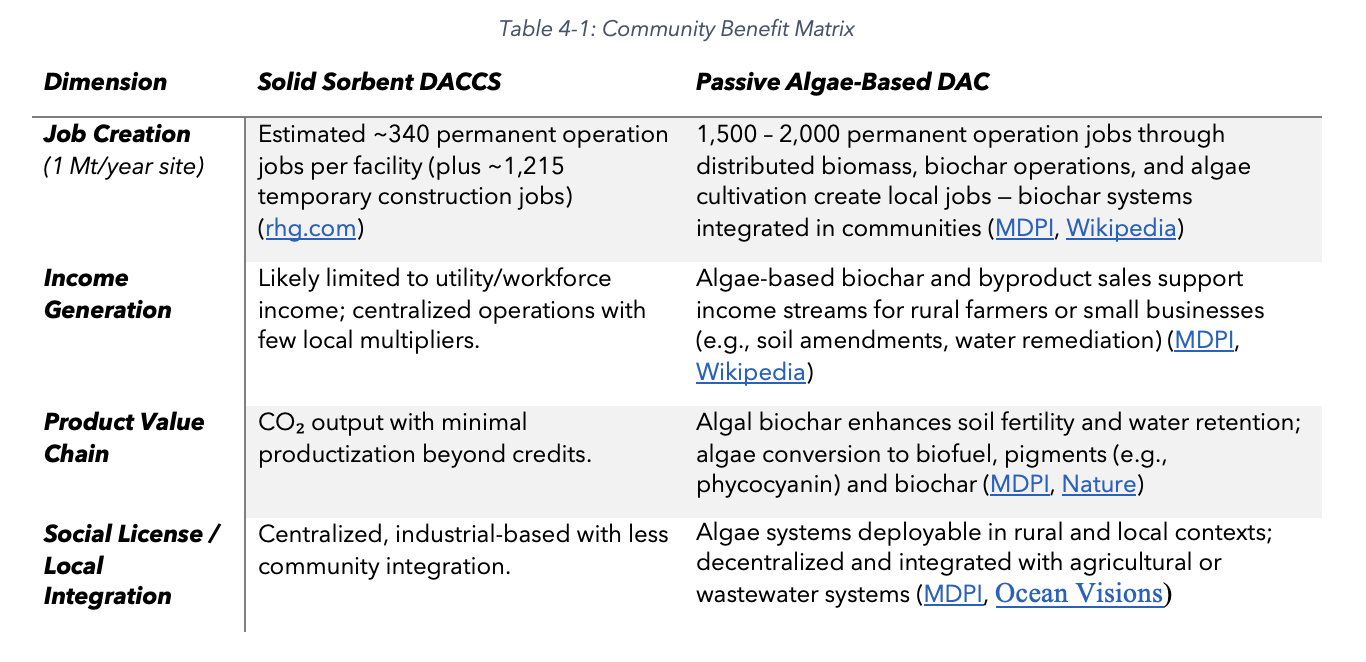
ICVCM core carbon principles (CCP) scoring
The Integrity Council for the Voluntary Carbon Market (ICVCM) has defined 10 Core Carbon Principles (CCPs) that guide the evaluation of which carbon credits are considered “high quality.” Passive Algae Photobioreactor (PBR) DAC meets or exceeds all 10 CCPs and excels in equity, transparency, and sustainability.
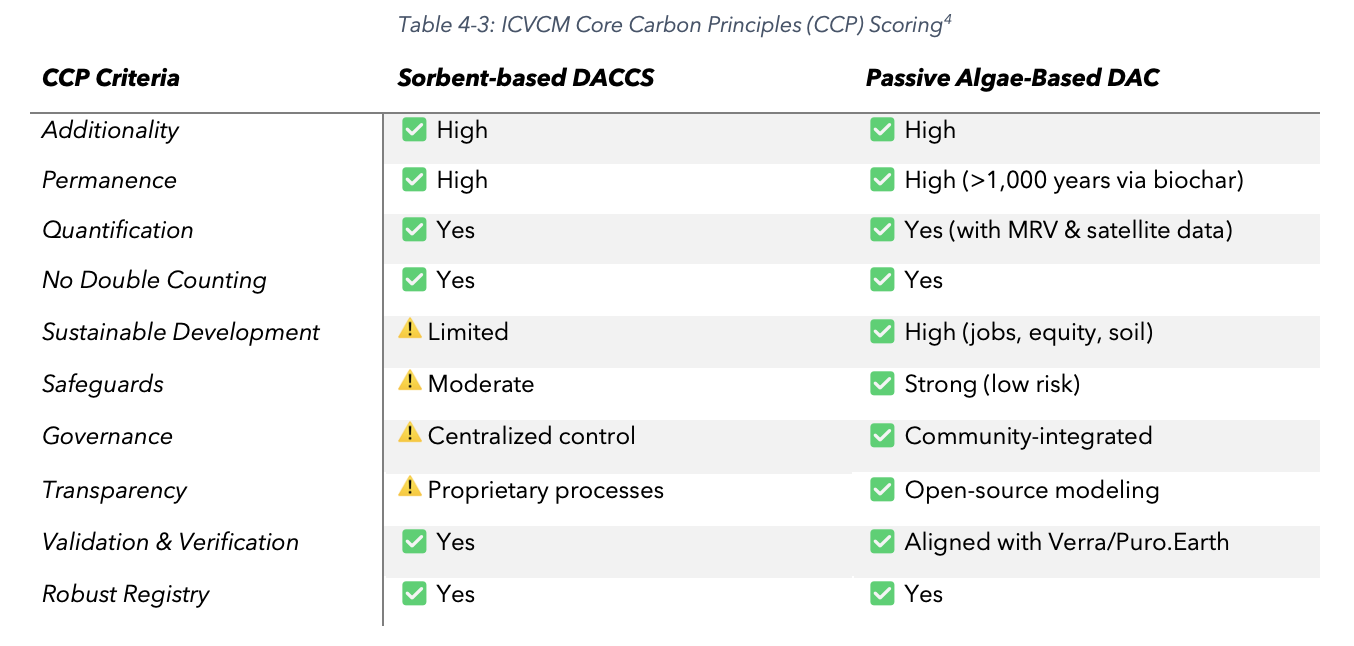
Resilience, durability, and LTVC
As global systems face increasing volatility — from energy markets to geopolitical instability — the long-term value of carbon removal technologies will hinge on their ability to withstand disruption. Resilience and durability are not just technical metrics — they are economic imperatives. Technologies that rely on fragile supply chains, high energy inputs, or extensive infrastructure are more susceptible to higher financial risk and lower investor confidence. In contrast, modular, low-input systems, such as Passive Algae-Based DAC, offer a durable, distributed, and risk-resilient model for scalable decarbonization.
Durability:
- Sorbent-based DACCS utilises mineral carbonation and geological injection, with a long-term storage risk.
- The Passive Algae Photobioreactor (PBR) DAC, which sequesters CO₂ in biochar, is a stable carbon form with permanence exceeding 1,000 years and co-benefits for soil regeneration.
Resilience:
- Sorbent-based DACCS relies on complex infrastructure, permitting, and industrial inputs.
- The Passive Algae Photobioreactor (PBR) DAC scales modularly, utilises natural resources, and thrives in urban, rural, or remote environments.
Resilience and durability directly affect the total cost of ownership and the real-world success of CDR technologies. Passive Algae-Based DAC not only delivers high-integrity carbon removal — it does so through a system architecture that is resistant to energy shocks, supply chain fragility, and regulatory bottlenecks. In economic terms, resilience lowers lifetime risk, and durability protects climate outcomes — both of which strengthen long-term value creation (LTVC).
Table 5-1 below distils the core economic and operational performance criteria of competing DAC technologies into a comparative LTVC framework. It clearly illustrates that Passive Algae-Based DAC outperforms high-cost alternatives, such as sorbent-based DAC systems, across key metrics, reinforcing that economically viable, socially integrated, and resilient systems are a more strategic path forward for achieving scalable and sustainable climate impact.

Furthermore, Table 6-1 below illustrates how carbon credit pricing is directly tied to credit quality, permanence, and co-benefits, providing a market-based rationale for investing in higher-integrity CDR solutions. It supports the economic argument that technologies like Passive Algae-Based DAC, which deliver durable and multifaceted benefits, can command significantly higher credit prices — thereby enhancing financial viability and investor returns.
Passive Algae Photobioreactor (PBR) DAC credits can also qualify for biodiversity, soil health, and ESG-linked premiums, increasingly favoured by corporate buyers and national procurement programs.
Paying attention to economics = Net-zero success
Paying attention to economic fundamentals like CAPEX, OPEX, co-benefits, and community integration is not an afterthought — it’s the difference between:
- Carbon removal projects that scale and serve society, and
- Projects that stall, lose public support, or collapse when subsidies fade.
We cannot solve climate change with fragile, centralised, high-risk industrial bets alone.
Economics matters. LTVC matters. Community impacts matter.
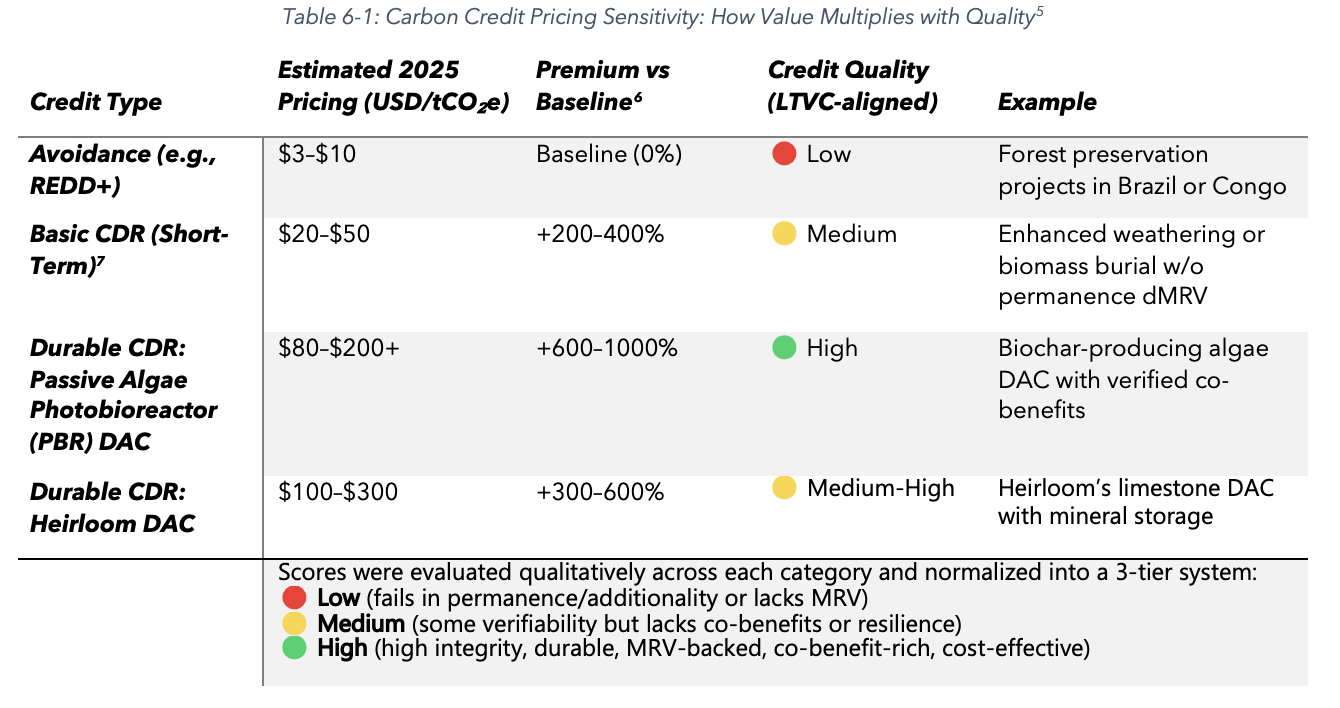
Final takeaways
Sorbent-based DACCS represents a bold but capital-intensive, limited-impact approach to DAC. The Passive Algae Photobioreactor (PBR) DAC offers a low-cost, high-value, community-driven pathway to carbon removal with embedded co-benefits. The future of carbon removal must be:
- Economically scalable
- Ecologically regenerative
- Socially equitable
- Technologically resilient
About PurFi.ai: Unlocking nature-based carbon solutions at scale
PurFi.ai is an AI-enabled platform that empowers Carbon Engineering Project Developers (CEPDs) to design, finance, and scale high-integrity, nature-based carbon removal solutions—with a special focus on durable pathways, such as algae-derived biochar and passive DAC systems. Through our integrated project planning, lifecycle carbon accounting, and carbon credit tokenisation tools, we enable stakeholders to transform natural systems into economically viable, traceable, and verifiable carbon sinks. Our value proposition is simple yet powerful: Deliver profitable, resilient, and dMRV-backed carbon removals that meet the highest integrity standards—while generating economic opportunity and ecosystem regeneration at the community level. As VCM demand shifts rapidly toward high-quality, durable CDR credits, PurFi.ai is expanding its role as a trusted partner in unlocking nature-based solutions that outperform in terms of climate, capital, and co-benefits.
As the sustainability clock ticks, we can’t afford to fund the wrong future. Frameworks that incorporate vital economic and financial metrics (such as LTVC) must be our guiding star.
References:
[1] https://www.belfercenter.org/publication/prospects-direct-air-carbon-capture-and-storage-costs-scale-and-funding?utm_source=chatgpt.com, https://www.iea.org/energy-system/carbon-capture-utilisation-and-storage/direct-air-capture, Techno-economic Analysis of Direct Air Carbon Capture with CO2 Utilisation at https://doi.org/10.1016/j.ccst.2021.100025, https://en.wikipedia.org/wiki/Direct_air_capture?utm_source=chatgpt.com, Expert Insights Into Future Trajectories: Assessing Cost Reductions And Scalability Of Carbon Dioxide Removal Technologies at https://doi.org/10.3389/fclim.2024.1331901
[2] Integrated Techno-Economic and Life Cycle Assessment of a Novel Algae-Based Coating for Direct Air Carbon Capture and Sequestration, at https://doi.org/10.1016/j.jcou.2023.102421
[3] 6 Things to Know About Direct Air Capture, https://www.wri.org/insights/direct-air-capture-resource-considerations-and-costs-carbon-removal
[4] Assessment of each DAC option against the ICVCM’s Core Carbon Principles (CCPs) draws on publicly stated attributes, verified methodologies, and CCP approvals. Heirloom’s mineralisation-based DAC claims permanence, verification, and registry tracking. Biochar pathways benefit from CCP-approved methodologies recognised for durability, sustainable development, and MRV in Verra-aligned systems.
[5] Carbon credit types are assessed using an LTVC framework, which incorporates long-term economic, environmental, and societal value metrics. Quality ratings reflect a combination of carbon permanence, additionality, MRV robustness, circular co-benefits, project accessibility, and social equity. Premiums over avoidance credits are derived from market data (e.g., Patch, ICROA, CarbonPlan), indicating the buyer’s willingness to pay more for high-integrity carbon removals.
[6] https://www.patch.io/, https://icroa.org/, https://carbonplan.org/research/cdr-counterfactual-accounting-methods
[7] A Basic Carbon Dioxide Removal (CDR) credit refers to a credit issued from a carbon removal process that: Physically removes CO₂ from the atmosphere; Does not guarantee permanence (>100 years); Often lacks robust Measurement, Reporting, and Verification (MRV); May not meet emerging ICVCM Core Carbon Principles.

